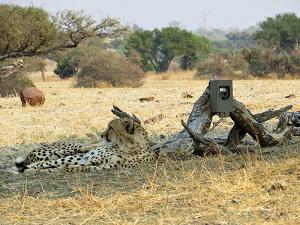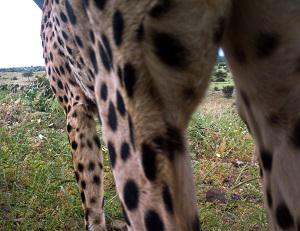Eleanor Brassine
The purpose of this study is to generate estimates of population abundance of the cheetah population of the Northern Tuli Game reserve and to identify threats, particularly anthropogenic conflicts outside of the reserve, to ascertain whether or not cheetahs contribute substantially to livestock loss in an attempt to reduce and mitigate human-cheetah conflict.

Cheetah lying next to camera trap set at a scent marking tree.
Cheetahs are under threat due to an increasing loss of habitat and conflicts with humans. The current status and distribution of the cheetah population in the Northern Tuli Game Reserve is largely unknown. Cheetahs have very large home ranges that often expand beyond reserve boundaries. Areas outside protected land may become population sinks as a result of human-induced mortality. This can have a severe impact on overall population number and dynamics, and may contribute to local extinction. The vast range use of the cheetahs and their diurnal activities is also a cause for concern as they are more likely to face human conflicts than other large predators. This emphasises the need for conservation actions of cheetahs outside protected areas for overall population survival.

Cheetah scent marking camera trap.
Furthermore, their movements have unknown implications for human-predator conflict in the region. Understanding cheetah movements and identifying the level of conflict outside the reserve is fundamental for the development of an effective conflict resolution and conservation strategy. In order to effectively conserve and determine the threats to the local cheetah population, it is important to have reliable estimates of population sizes and information on population range use and demographics.
These data will be collected through remote sensing and field surveys. Cheetah population estimates can be directly estimated by identifying individuals within a population. Individuals can be identified form their unique spot patterns. Photographs collected from camera traps and from donations from guides, tourists and residents will be used to identify each individual cheetah in the Northern Tuli population to estimate occurrence and population size. Another aspect of this study will evaluate the level of cheetah-human conflict on communal farmlands through the use of a questionnaire survey.